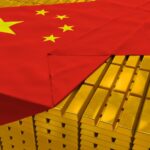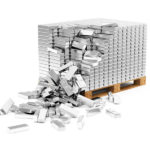Jerome Powell is Wrong: The Gold Standard Could Help to Solve Most of The Dire Economic Problems In A Changing World
(July 11, 2019 - Adam Garrie)
Federal Reserve Chairman Jerome Powell just arrogantly dismissed the potential that a restored gold standard could offer to Americans and those whose economic interests are indelibly linked with American productivity and solvency. But far from just helping ordinary American workers, savers and entrepreneurs, a gold standard could help the world to enter into a more stable and free economic age.
Perhaps ironically, Powell’s monetarily authoritarian remarks about gold were likely inspired by the fact that Donald Trump seeks to appoint the pro-gold Judy Shelton to the Federal Reserve’s influential board of governors. In this sense, Powell’s remarks are symptomatic of someone speaking from defensive position. As such, Powell’s defensive remarks are demonstrative of the fact that more and more people are looking to gold as a means of getting out of the inflationary traps and debt traps that are implicitly cyclical when one’s economy is predicated on the artificial value of a fiat currency.
A gold standard is not only the sole way to help new businesses and workers looking for an honest loan by combining low interest rates with a stable currency that is good for savers and consumers, but a return to the gold standard could also help to ease international tensions in respect of trade wars and consternation stemming from debt crises in multiple emerging markets.
As the two most important economies in the world, China and the United States ought to look to the long term and see a golden future of win-win possibilities that would be good not only for the world’s largest economies but for the world as a whole.
China and the United States continue to delve deeper into a globally destabilising economic cold war. Owing to the US embargo on key Chinese tech products (namely Huawei products), this commercial cold war now goes far beyond even a traditional tariff war. In the short term, both sides are gunning for position as neither wants to lose revenue and neither wants to lose face. But in the long term, the success of both economic superpowers will depend on stable and depoliticised monetary policy.
Although neither the US nor China peg their currency to a metallic standard, unlike the US, China has exercised a comparatively conservative monetary policy which both avoids the pitfalls of a freely floating fiat currency whilst also offering the slight flexibility that comes from a managed float of the renminbi.
Ultimately though, the monetary stability that comes from a metallic standard will mean two things by the end of the 21st century. First of all, it will be the final piece of the puzzle in respect of China’s rise to the status of economic world leader. Secondly, it could represent the United States truly making itself great again by rejecting the fiat currency dept traps that fuel the military-industrial complex whilst destroying the country’s long term economic fortunes.
China has been quietly buying a great deal of gold on the global market and while this in no way indicates a desire in Beijing to pivot to a gold standard anytime soon, it does at minimum indicate the fact that China’s leadership is thinking of a long term reality in which gold will provide a crucial shelter during an economic rainy day (or season, or year or multiple years).
Turning back to the US, one must make it clear that if the US went back on the gold standard, the following positive developments could be achieved:
–internal price stability/low inflation
–low interest rates that do not unsustainably balloon the money supply
–a shift away from financial capitalism and real estate speculation and a pivot back to investments in productive industries including both large scale manufacturing as well as small and medium sized businesses
–a government that would be forced to live within its means (including the military -industrial complex which relies heavily on subsidies made possibly through an out of control money supply)
–better long term prospects for low and middle earning savers
–the ability of ordinary people to once again own rather than rent their own properties
–a shift away from speculation and a return to saving
–monetary policy removed as a tool of social engineering and geopolitical manipulation
In respect of international conditions, a return to gold would solve the primary grievance that Donald Trump claims to have vis-a-vis China and the best part is that it would solve that matter without the need to resort to punitive tariffs, sanctions or a trade embargo.
One of Donald Trump’s chief complaints is that Chinese goods are priced too competitively. Although this accusation stems from a misreading of China’s internal development model, when one talks about international trade, every country in the world that uses a fiat currency is by definition a currency manipulator. It is the radical differences in the values of fiat currencies world wide that allow for major price gaps in the value of international imports and exports between nations. Likewise, it is the radical shifts in the value of these fiat currencies that cause international trade to become a speculator’s paradise rather than simply the mainstay of producers and consumers in a free economy.
By contrast, if all nations were to price their goods based on a local currency that is worth a specific amount in gold, the international prices of goods would become immensely more stable. As such, the penultimate desirability of a product would be based primarily on its quality and on its real world price competitiveness. This contrasts with goods whose international prices can be easily manipulated due to unstable monetary systems.
To be sure, China’s crawling peg renminbi is less manipulated than the freely floating dollar but in reality, all currencies not tied to a commodity of universal value like gold are ultimately tools to be manipulated rather than a universal value that no one government can control.
At a time when the US is still the world’s largest economy in terms of GDP, if Washington asked the world to price its goods based on their value in terms of gold rather than in terms of a fiat dollar, the United States would be able to shape a future in which the global prices of both imports and exports would be far stabler, thus ending any accusations that cheap imports are the result of currency manipulation. The fact that the US was a major world exporter when on the classical gold standard likewise offers a clear template for how gold can result in win-win outcomes in respect of both imports and exports.
When it comes to countries that refuse to price their goods in gold, the US can level a fair and flat tariff on all such goods until such a time that an import partner is willing to price their goods in terms of gold rather than a fiat currency.
Inversely, if the US waits to begin a pivot to gold, it may well be China telling the US that it will only take payment of its exports in gold. If unprepared for such a day, this would leave the US at a severe and genuine disadvantage, quite unlike the imagined disadvantage that Trump believes exists today.
The best solution would be for China and the US to dig their way out of their current trading dispute by agreeing to a medium term phased transition to a gold backed trading regime. By solving the monetary issue once and for all, open, free and crucially fair trade would exist on both sides in a way that no one could genuinely complain about unless they are simply opposed to free market systems.
China and the US could therefore work mutually to shift back to gold and once the two largest economies were to do this, the rest of the world would surely follow in due course.






